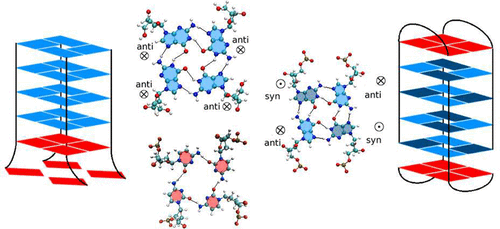当前位置:
X-MOL 学术
›
ACS Chem. Neurosci.
›
论文详情
Our official English website, www.x-mol.net, welcomes your
feedback! (Note: you will need to create a separate account there.)
Structural and Dynamical Characterization of DNA and RNA Quadruplexes Obtained from the GGGGCC and GGGCCT Hexanucleotide Repeats Associated with C9FTD/ALS and SCA36 Diseases
ACS Chemical Neuroscience ( IF 4.1 ) Pub Date : 2017-12-27 00:00:00 , DOI: 10.1021/acschemneuro.7b00476 Yuan Zhang 1 , Christopher Roland 1 , Celeste Sagui 1
ACS Chemical Neuroscience ( IF 4.1 ) Pub Date : 2017-12-27 00:00:00 , DOI: 10.1021/acschemneuro.7b00476 Yuan Zhang 1 , Christopher Roland 1 , Celeste Sagui 1
Affiliation

|
A (GGGGCC) hexanucleotide repeat (HR) expansion in the C9ORF72 gene has been considered the major cause behind both frontotemporal dementia and amyotrophic lateral sclerosis, while a (GGGCCT) is associated with spinocerebellar ataxia 36. Recent experiments involving NMR, CD, optical melting and 1D 1H NMR spectroscopy, suggest that the r(GGGGCC) HR can adopt a hairpin structure with G-G mismatches in equilibrium with a G-quadruplex structure. G-Quadruplexes have also been identified for d(GGGGCC). As these experiments lack molecular resolution, we have used molecular dynamics microsecond simulations to obtain a structural characterization of the G-quadruplexes associated with both HRs. All DNA G-quadruplexes, parallel or antiparallel, with or without loops are stable, while only parallel and one antiparallel (stabilized by diagonal loops) RNA G-quadruplexes are stable. It is known that antiparallel G-quadruplexes require alternating guanines to be in a syn conformation that is hindered by the C3′-endo pucker preferred by RNA. Initial RNA antiparallel quadruplexes built with C2′-endo sugars evolve such that the transition (C2′-endo)-to-(C3′-endo) triggers unwinding and buckling of the flat G-tetrads, resulting in the unfolding of the RNA antiparallel quadruplex. Finally, a parallel G-quadruplex stabilizes an adjacent C-tetrad in both DNA and RNA (thus effectively becoming a mixed quadruplex of 5 layers). The C-tetrad is stabilized by the stacking interactions with the preceding G-tetrad, by cyclical hydrogen bonds C(N4)-(O2), and by an ion between the G-tetrad and the C-tetrad. In addition, antiparallel DNA G-quadruplexes also stabilize flat C-layers at the ends of the quadruplexes.
中文翻译:

从与 C9FTD/ALS 和 SCA36 疾病相关的 GGGGCC 和 GGGCCT 六核苷酸重复中获得的 DNA 和 RNA 四链体的结构和动态表征
C9ORF72 基因中的 (GGGGCC) 六核苷酸重复 (HR) 扩增被认为是额颞叶痴呆和肌萎缩侧索硬化症背后的主要原因,而 (GGGCCT) 与脊髓小脑共济失调有关 36。最近的实验涉及 NMR、CD、光学熔解和1D 1 H NMR光谱表明,r(GGGGCC) HR可以采用发夹结构,其中GG错配与G四链体结构平衡。d(GGGGCC) 也已被鉴定为 G-四联体。由于这些实验缺乏分子分辨率,我们使用分子动力学微秒模拟来获得与两个 HR 相关的 G 四链体的结构表征。所有DNA G-四链体,平行或反平行,带或不带环都是稳定的,而只有平行和一个反平行(通过对角线环稳定)RNA G-四链体是稳定的。众所周知,反向平行的 G-四链体需要交替的鸟嘌呤才能处于顺式构象,而这种构象受到 RNA 偏好的 C3'-内皱褶的阻碍。最初由 C2'-内糖构建的 RNA 反平行四链体不断演化,使得 (C2'-endo) 到 (C3'-endo) 的转变触发平坦 G-四分体的解旋和屈曲,从而导致 RNA 反平行四联体的展开四联体。最后,平行的 G 四联体稳定了 DNA 和 RNA 中相邻的 C 四联体(从而有效地成为 5 层的混合四联体)。C-四分体通过与前面的 G-四分体的堆积相互作用、通过环状氢键 C(N4)-(O2) 以及通过 G-四分体和 C-四分体之间的离子来稳定。此外,反平行 DNA G 四链体还可稳定四链体末端的平坦 C 层。
更新日期:2017-12-27
中文翻译:

从与 C9FTD/ALS 和 SCA36 疾病相关的 GGGGCC 和 GGGCCT 六核苷酸重复中获得的 DNA 和 RNA 四链体的结构和动态表征
C9ORF72 基因中的 (GGGGCC) 六核苷酸重复 (HR) 扩增被认为是额颞叶痴呆和肌萎缩侧索硬化症背后的主要原因,而 (GGGCCT) 与脊髓小脑共济失调有关 36。最近的实验涉及 NMR、CD、光学熔解和1D 1 H NMR光谱表明,r(GGGGCC) HR可以采用发夹结构,其中GG错配与G四链体结构平衡。d(GGGGCC) 也已被鉴定为 G-四联体。由于这些实验缺乏分子分辨率,我们使用分子动力学微秒模拟来获得与两个 HR 相关的 G 四链体的结构表征。所有DNA G-四链体,平行或反平行,带或不带环都是稳定的,而只有平行和一个反平行(通过对角线环稳定)RNA G-四链体是稳定的。众所周知,反向平行的 G-四链体需要交替的鸟嘌呤才能处于顺式构象,而这种构象受到 RNA 偏好的 C3'-内皱褶的阻碍。最初由 C2'-内糖构建的 RNA 反平行四链体不断演化,使得 (C2'-endo) 到 (C3'-endo) 的转变触发平坦 G-四分体的解旋和屈曲,从而导致 RNA 反平行四联体的展开四联体。最后,平行的 G 四联体稳定了 DNA 和 RNA 中相邻的 C 四联体(从而有效地成为 5 层的混合四联体)。C-四分体通过与前面的 G-四分体的堆积相互作用、通过环状氢键 C(N4)-(O2) 以及通过 G-四分体和 C-四分体之间的离子来稳定。此外,反平行 DNA G 四链体还可稳定四链体末端的平坦 C 层。











































 京公网安备 11010802027423号
京公网安备 11010802027423号